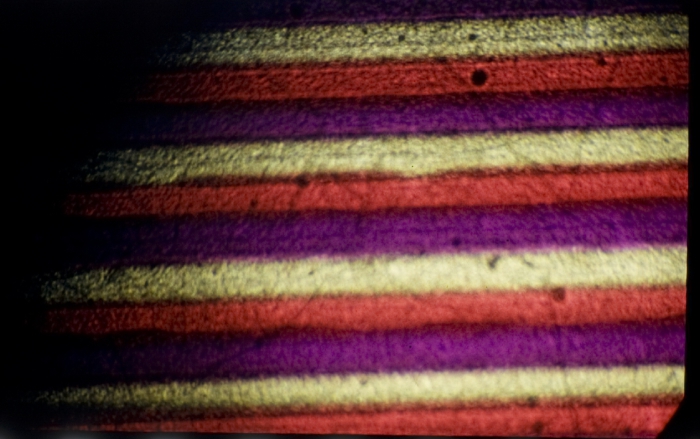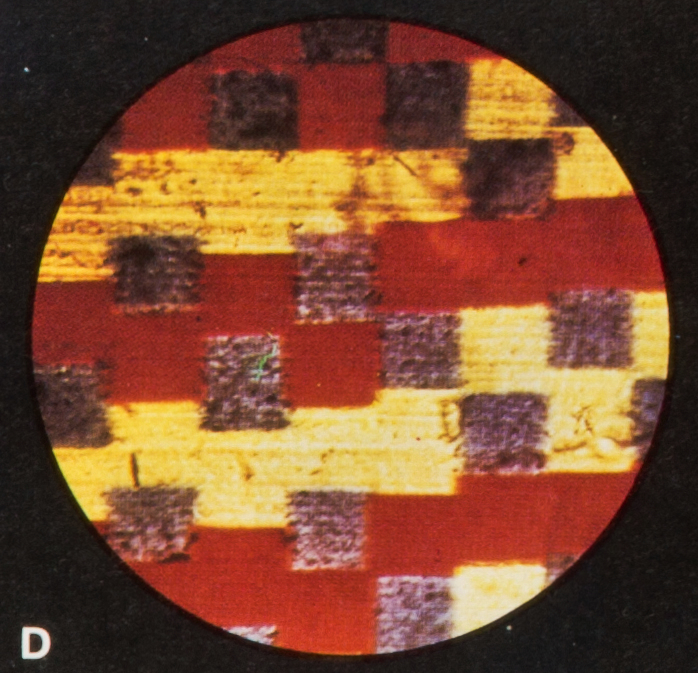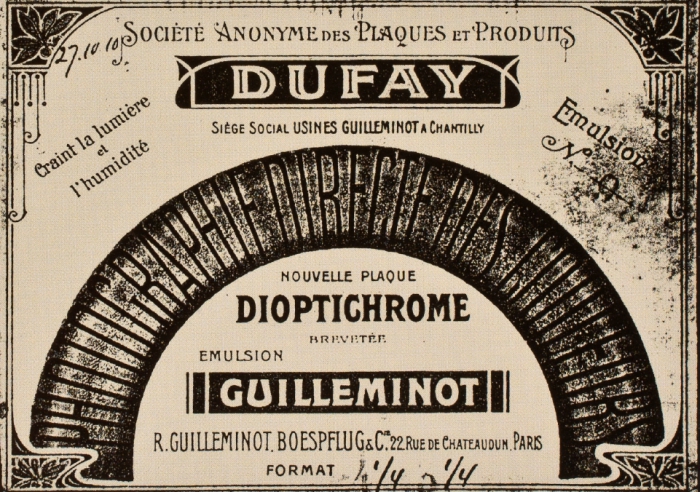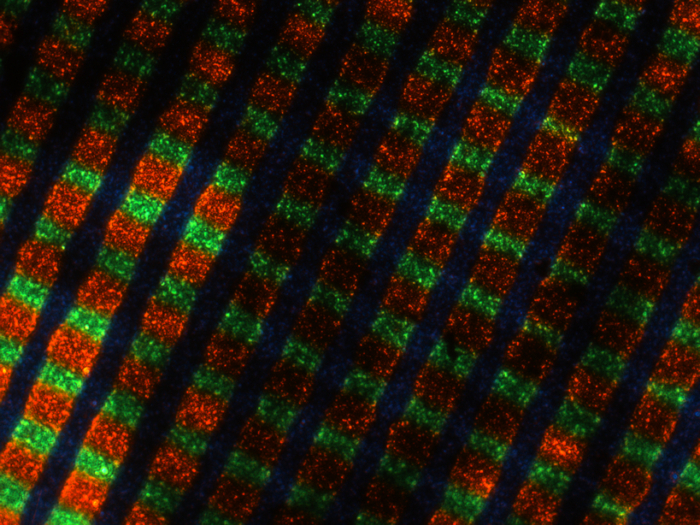-
![]() Photomicrograph (20x) of a Joly screen. Credit: Courtesy of George Eastman House, International Museum of Photography and Film.
Photomicrograph (20x) of a Joly screen. Credit: Courtesy of George Eastman House, International Museum of Photography and Film.
- Credit: Courtesy of George Eastman House, International Museum of Photography and Film.
- Source: Coe, Brian (1978): Colour Photography. The First Hundred Years 1840-1940. London: Ash & Grant.
- Credit: Gawain Weaver, Photograph Conservator, Gawain Weaver Art Conservation, San Anselmo, CA.
- Source: Pénichon, Sylvie (2013): Twentieth Century Colour Photographs. The Complete Guide to Processes, Identification & Preservation. London, Los Angeles: Thames & Hudson, p. 69.
- Source: Pénichon, Sylvie (2013): Twentieth Century Colour Photographs. The Complete Guide to Processes, Identification & Preservation. London, Los Angeles: Thames & Hudson, p. 22.
- Source: Pénichon, Sylvie (2013): Twentieth Century Colour Photographs. The Complete Guide to Processes, Identification & Preservation. London, Los Angeles: Thames & Hudson, p. 23.
Category: Line screen▼×
- All Categories
- Bibliography
- Chromogenic monopack
- Chromolytic multilayer
- Color separation
- Double-coated / bi-pack
- Edge Codes and Identification
- Hand coloring
- Other
- Printing / dye-transfer
- Printing / pigment process
- Screen processes
- Spatial synthesis (multiple lenses, beam splitter)
- Stencil coloring (pochoir, Pathécolor)
- Temporal synthesis (rotary filters)
- Theory
- Tinting
- Toning
“In 1894 Professor John Joly of Dublin patented a process for producing a screen of red, green and blue-violet lines by ruling them on a gelatin-coated glass plate. Joly used ruling machines of great accuracy, with drawing pens trailed across ...
“Another method of producing a line screen was patented in 1904 by the German Robert Krayn, and was demonstrated by him in November 1907. Krayn stained very thin celluloid sheets red, green and blue, and cemented them interleaved to form a thick ...
-
![]() Source: Coe, Brian (1978): Colour Photography. The First Hundred Years 1840-1940. London: Ash & Grant, p. 54.
Source: Coe, Brian (1978): Colour Photography. The First Hundred Years 1840-1940. London: Ash & Grant, p. 54.
- Source: Pénichon, Sylvie (2013): Twentieth Century Colour Photographs. The Complete Guide to Processes, Identification & Preservation. London, Los Angeles: Thames & Hudson, p. 34.
- Source: Pénichon, Sylvie (2013): Twentieth Century Colour Photographs. The Complete Guide to Processes, Identification & Preservation. London, Los Angeles: Thames & Hudson, p. 35.
- Source: Pénichon, Sylvie (2013): Twentieth Century Colour Photographs. The Complete Guide to Processes, Identification & Preservation. London, Los Angeles: Thames & Hudson, p. 35.
- Source: Pénichon, Sylvie (2013): Twentieth Century Colour Photographs. The Complete Guide to Processes, Identification & Preservation. London, Los Angeles: Thames & Hudson, p. 36.
- Source: Pénichon, Sylvie (2013): Twentieth Century Colour Photographs. The Complete Guide to Processes, Identification & Preservation. London, Los Angeles: Thames & Hudson, p. 74.
- Source: Pénichon, Sylvie (2013): Twentieth Century Colour Photographs. The Complete Guide to Processes, Identification & Preservation. London, Los Angeles: Thames & Hudson, p. 74.
7 Images
Process for still photography in which light is filtered through a screen or transparent plate covered in lines or dots in the primary colors orange, green and violet. For the positive, the process relies on a support material which includes an ...
(see detail page on Dufaycolor)
-
![]() Coote, Jack H. (1993): The Illustrated History of Colour Photography. Surbiton, Surrey: Fountain Press,
Coote, Jack H. (1993): The Illustrated History of Colour Photography. Surbiton, Surrey: Fountain Press,
- Credit: Cinémathèque française, conservatoire des techniques, Paris.
- Source: Ede, François (1994): Jour de fête ou la couleur retrouvée. Cahiers du Cinéma: Paris.
- Pénichon, Sylvie (2013): Twentieth Century Colour Photographs. The Complete Guide to Processes, Identification & Preservation. London, Los Angeles: Thames & Hudson, p. 71.
- Source: Pénichon, Sylvie (2013): Twentieth Century Colour Photographs. The Complete Guide to Processes, Identification & Preservation. London, Los Angeles: Thames & Hudson, p. 73.
- Source: Pénichon, Sylvie (2013): Twentieth Century Colour Photographs. The Complete Guide to Processes, Identification & Preservation. London, Los Angeles: Thames & Hudson, p. 31.
- Source: Pénichon, Sylvie (2013): Twentieth Century Colour Photographs. The Complete Guide to Processes, Identification & Preservation. London, Los Angeles: Thames & Hudson, p. 32.
- Source: Pénichon, Sylvie (2013): Twentieth Century Colour Photographs. The Complete Guide to Processes, Identification & Preservation. London, Los Angeles: Thames & Hudson, p. 33.
- Source: Pénichon, Sylvie (2013): Twentieth Century Colour Photographs. The Complete Guide to Processes, Identification & Preservation. London, Los Angeles: Thames & Hudson, p. 48.
- Source: Pénichon, Sylvie (2013): Twentieth Century Colour Photographs. The Complete Guide to Processes, Identification & Preservation. London, Los Angeles: Thames & Hudson, p. 69.
10 Images
“The most successful of all the screen processes was the one initiated by Louis Dufay. Today the product is known as Dufaycolor, but it was first introduced about 1910 as the Dioptichrome plate. The first Dufay patents were assigned to an ...
”The process as illustrated in USP 1431309 was a two-color additive process, but it is stated that it could be a three- or four-color process. For the original photography, the negative was exposed through a line screen composed of alternate bands ...
-
![]() Source: Ryan, Roderick T. (1977): A History of Motion Picture Color Technology. London: Focal Press.
Source: Ryan, Roderick T. (1977): A History of Motion Picture Color Technology. London: Focal Press.
1 Image
“The Warner-Powrie process patented in 1905 was the earliest commercial process using a screen made with bichromated colloid. A glass plate was thinly coated with bichromated gelatin or fish glue and exposed to light through a screen having ...
For a description of Spicer-Dufay see detail page on Dufaycolor)
-
![]() Magnification 20x. Credit: photomicrograph by Silvana Konermann. Source: Eggert, John (1932): Kurzer Überblick über den Stand der Farbenkinematographie. Bericht über den VIII. Internationalen Kongress für wissenschaftliche und angewandte Photographie, Dresden 1931, pp. 214-222. Leipzig: J. A. Barth.
Magnification 20x. Credit: photomicrograph by Silvana Konermann. Source: Eggert, John (1932): Kurzer Überblick über den Stand der Farbenkinematographie. Bericht über den VIII. Internationalen Kongress für wissenschaftliche und angewandte Photographie, Dresden 1931, pp. 214-222. Leipzig: J. A. Barth.
- Magnification 10x. Credit: photomicrograph by Silvana Konermann. Source: Eggert, John (1932): Kurzer Überblick über den Stand der Farbenkinematographie. Bericht über den VIII. Internationalen Kongress für wissenschaftliche und angewandte Photographie, Dresden 1931, pp. 214-222. Leipzig: J. A. Barth.
- Magnification 5x. Credit: photomicrograph by Silvana Konermann. Source: Eggert, John (1932): Kurzer Überblick über den Stand der Farbenkinematographie. Bericht über den VIII. Internationalen Kongress für wissenschaftliche und angewandte Photographie, Dresden 1931, pp. 214-222. Leipzig: J. A. Barth.
- Source: Eggert, John (1932): Kurzer Überblick über den Stand der Farbenkinematographie. In: Bericht über den VIII. Internationalen Kongress für wissenschaftliche und angewandte Photographie, Dresden 1931, pp. 214-222. Leipzig: J. A. Barth.
- Source: Coe, Brian (1981): The History of Movie Photography. Westfield, N.J.: Eastview Editions.
- Magnification of an image area. Source: Eggert, John (1932): Kurzer Überblick über den Stand der Farbenkinematographie. Bericht über den VIII. Internationalen Kongress für wissenschaftliche und angewandte Photographie, Dresden 1931, pp. 214-222. Leipzig: J. A. Barth.
- Source: Eggert, John (1932): Kurzer Überblick über den Stand der Farbenkinematographie. Bericht über den VIII. Internationalen Kongress für wissenschaftliche und angewandte Photographie, Dresden 1931, pp. 214-222. Leipzig: J. A. Barth.
78 Images in 2 Galleries
Dufaycolor was a regular line screen process whereby the incident light was filtered through a pattern of tiny color patches created by lines in red, green and blue, the so called réseau.
-
![]() Reversal Colour Positive. Credit: Courtesy of BFI National Archive. Photograph by Barbara Flueckiger. Film: A Colour Box (GB 1935, Len Lye).
Reversal Colour Positive. Credit: Courtesy of BFI National Archive. Photograph by Barbara Flueckiger. Film: A Colour Box (GB 1935, Len Lye).
- Microscopic image of the filter structure of a Dufaycolor film. The Emulsion has been removed. The visible structures are not silver grain but the structure of the filter layers. Credit: David Pfluger, ERC Advanced Grant FilmColors. Imaging was performed with support of the Center for Microscopy and Image Analysis, University of Zurich.
- Microscopic images of Dufaycolor film with the focus set at different points within the emulsion and filter layers. The images have been chained to show a travelling through the 3-dimensional structure of the layers. Credit: David Pfluger, conversion to video by Martin Weiss, ERC Advanced Grant FilmColors. Imaging was performed with support of the Center for Microscopy and Image Analysis, University of Zurich.
231 Images in 9 Galleries
-
![]() Linear filter structure in Polavision instant Super8 film. The filter lines are running along the film strip. According to the image placement of the Super-8 motion picture standard the image is divided vertically into triplets of R, G and B filter lines. The emulsion layer has been removed before this image was taken.
Credit: David Pfluger, ERC Advanced Grant FilmColors. Imaging was performed with support of the Center for Microscopy and Image Analysis, University of Zurich.
Linear filter structure in Polavision instant Super8 film. The filter lines are running along the film strip. According to the image placement of the Super-8 motion picture standard the image is divided vertically into triplets of R, G and B filter lines. The emulsion layer has been removed before this image was taken.
Credit: David Pfluger, ERC Advanced Grant FilmColors. Imaging was performed with support of the Center for Microscopy and Image Analysis, University of Zurich.
- Linear filter structure in Polavision instant Super8 film with an emulsion layer of a high photographic density. With the focus set on the emulsion the linear structure of the coloured filters is not visible in this image. Credit: David Pfluger, ERC Advanced Grant FilmColors. Imaging was performed with support of the Center for Microscopy and Image Analysis, University of Zurich.
- Comparision of the linear filter structure of Polachrome 35mm instant slide film and Polavision Super-8 motion picture film. While the technical concept behind the two film stocks is the same, the Super-8 film was produced with linear filters of a smaller width. Based on the given width of an RGB filter triplet and the 135 still image size there are about 920 horizontal RGB-triplets per image for a Polachrome slide. The Super-8 film image is rotated by 90° compared to the 135 film still image and has about 340 vertical RGB-triplets per frame. The positioning of the image content compared to the filter lines is indicated in the picture. Credit: David Pfluger, ERC Advanced Grant FilmColors. Imaging was performed with support of the Center for Microscopy and Image Analysis, University of Zurich.
- Excerpt of a Polavision Super-8 home movie scanned on a Kinetta scanner in 4.8K resolution edge to edge. In post production a zoom in and out was applied to show the linear filter structure of Polavision film in motion. The zoom was based on image detail from the scan. No upres procedure was applied. Credit: Scanning and editing by Martin Weiss.
- A comparison of the colour filter structures of Dufaycolor, Autochrome and Polavision from Anonymous (1978): Ma il Polavision e' un'altra cosa!. Phototest Italiana, 41, Oct., pp 72–77.
- A comparison of the colour filter structures of Dufaycolor, Autochrome and Polavision from Anonymous (1978): Ma il Polavision e' un'altra cosa!. Phototest Italiana, 41, Oct., pp 72–77. Translation: David Pfluger and Giorgio Trumpy.
- The process of exposure and development of Polavision instant Super-8 film. From Anonymous (1978): Ma il Polavision e' un'altra cosa!. Phototest Italiana, 41, Oct., p. 74.
- The process of exposure and development of Polavision instant Super-8 film. From Anonymous (1978): Ma il Polavision e' un'altra cosa!. Phototest Italiana, 41, Oct., p. 74. Translation: David Pfluger and Giorgio Trumpy.
- "Polavision (top) vs. Kodachrome 40: These are blowups from closely matching frames of Debra Goldie, filmed simultaneously with a Polavision and a conventional super 8 camera, side by side, with the Twi Light quartz lamp mounted on top of the former. Subject distance was 6 ft., but the super 8 camera was focused for 10 ft. – same as the Polavision camera at its close-up setting. Both Polavision and Kodachrome 40 are closely equal in speed, but differ distinctly in structure, faithfulness of color rendition, and latitude, as is obvious from these frame reproductions. What can't be seen is the relative opacity of Polavision: according to our measurement, it transmits less than 9 percent as Kodachrome 40. However, the lab that made the duplicate transparency blow-ups of the frames found that it had to give a full six stops extra exposure." (Leavitt, Don; Drukker Leendert (1978): First Look: Polavision instant movies. In: Popular Photography, Feb., p. 68.)
- "C'est devant un immense agrandissement de l'intérieur d'une cassette Polavision sur la-quelle se découpe la silhouette de l'orateur (ci-contre à gauche) que le Dr Land présenta son invention. Ce document permet de distinguer les poulies de guidage du film (1 et 2), la réserve de produit de traitement et son bec ré-partiteur (3), la bobine débitrice (4), l'ensemble formé par le presseur de film et le prisme (5), la poulie d'entraînement du film (6)." "It was in front of a huge enlargement of the interior of a Polavision cassette on which the silhouette of the speaker was cut out (opposite left) that Dr Land presented his invention. This document makes it possible to distinguish the guide pulleys of the film (1 and 2), the supply of treatment product and its distribution nozzle (3), the supply reel (4), the assembly formed by the presser of film and the prism (5), the film drive pulley (6)." (Anonymous (1977): Naissance du cinéma instantané. In: L'auto-journal, Rubrique realisée sous la direction de Pierre Marais, 12, Jul., pp. 94–95.)
- The production of the Filter structure on Polavision film includes the use of a lenticular surface, which is removed after the process. The lenticules are not involved in recording the color information during the taking of images in the camera. Figure 10 and Figure 11 from: Land, Edwin H. (1997): An Introduction to Polavision. In: Photographic Science and Engineering, 21,5, Sept., Oct., pp. 228–236, on p. 228.
- Comparison of thickness of the image carrying layer in a Kodak fine grain positive and Polavision film. Figure 24 from: Land, Edwin H. (1997): An Introduction to Polavision. In: Photographic Science and Engineering, 21,5, Sept., Oct., pp. 228–236, on p. 235.
- In the Polavision instant color film process the negative image recorded during the exposure of the film is neither developed from a latent image to a visible negative nor is it removed from the film. The latent negative stays as a layer in the film and is responsible for a slight attenuation of the image’s highlights. Figure 25 from: Land, Edwin H. (1997): An Introduction to Polavision. In: Photographic Science and Engineering, 21,5, Sept., Oct., pp. 228–236, on p. 236.
- Single frame of a Polavision home movie scanned in 3.5K resolution.
14 Images
-
![]() Linear filter structure in Polachrome 35mm instant slide film. The blue filter strips are slightly larger compared to the red and green filters. The filter lines are running along the film strip. According to the image placement of the 135 film format for still photography the image is divided horizontally into triplets of R, G and B filter lines.
The emulsion layer has been removed before the image was taken.
Credit: David Pfluger, ERC Advanced Grant FilmColors. Imaging was performed with support of the Center for Microscopy and Image Analysis, University of Zurich.
Linear filter structure in Polachrome 35mm instant slide film. The blue filter strips are slightly larger compared to the red and green filters. The filter lines are running along the film strip. According to the image placement of the 135 film format for still photography the image is divided horizontally into triplets of R, G and B filter lines.
The emulsion layer has been removed before the image was taken.
Credit: David Pfluger, ERC Advanced Grant FilmColors. Imaging was performed with support of the Center for Microscopy and Image Analysis, University of Zurich.
- Linear filter structure in Polachrome 35mm instant slide film with a emulsion layer of low photographic density. Credit: David Pfluger, ERC Advanced Grant FilmColors. Imaging was performed with support of the Center for Microscopy and Image Analysis, University of Zurich.
- Comparision of the linear filter structure of Polachrome 35mm instant slide film and Polavision Super-8 motion picture film. While the technical concept behind the two film stocks is the same, the Super-8 film was produced with linear filters of a smaller width. Based on the given width of an RGB filter triplet and the 135 still image size there are about 920 horizontal RGB-triplets per image for a Polachrome slide. The Super-8 film image is rotated by 90° compared to the 135 film still image and has about 340 vertical RGB-triplets per frame. The positioning of the image content compared to the filter lines is indicated in the picture. Credit: David Pfluger, ERC Advanced Grant FilmColors. Imaging was performed with support of the Center for Microscopy and Image Analysis, University of Zurich.










